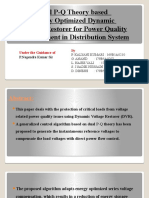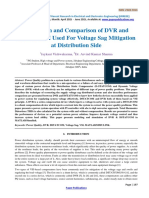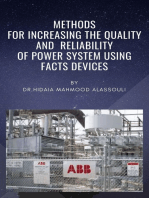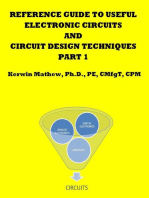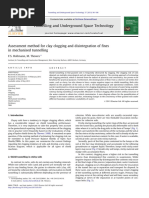Sivaram PDF
Sivaram PDF
Uploaded by
Lava KumarCopyright:
Available Formats
Sivaram PDF
Sivaram PDF
Uploaded by
Lava KumarOriginal Description:
Original Title
Copyright
Available Formats
Share this document
Did you find this document useful?
Is this content inappropriate?
Copyright:
Available Formats
Sivaram PDF
Sivaram PDF
Uploaded by
Lava KumarCopyright:
Available Formats
International Journal of Engineering Research and Development
e-ISSN: 2278-067X, p-ISSN: 2278-800X, www.ijerd.com
Volume 10, Issue 7 (July 2014), PP.01-15
Reduction of Voltage Imbalance in a Two Feeder Distribution
System Using Iupqc
S.Sarada1, S.Anupama2, and T.Siva Ram3
1
Assistant Professor, Dept of EEE, Annamacharya Institute of Technology & Sciences, Rajampet, India
Assistant Professor, Dept of EEE, Annamacharya Institute of Technology & Sciences, Rajampet, India
3
PG Student, Dept of EEE, Annamacharya Institute of Technology & Sciences, Rajampet, Andhra Pradesh,
2
Abstract: - Day by day the use of sophisticated electronic devices is increased. Unfortunately these devices are
very sensitive to power quality disturbances. Power quality disturbances is an occurrence manifested as a
nonstandard voltage, current, or frequency that results in tripping or failure of end use equipments. One of the
major problems dealt here are power sag/swell. To solve this problem custom devices are used. Among these,
the distribution static compensator, dynamic voltage restorer and unified power quality conditioner which are
based on the VSC principle are used for power quality improvement. This paper mainly proposes a new
connection for a interline unified power quality conditioner (IUPQC) to improve the power quality between two
feeders in a distribution system. The proposed configuration of the UPQC is developed and verified for various
Power quality disturbances by simulating the model using MATLB/SIMULINK.
Index Terms: - Power Quality, PQ disturbances, Interline unified power flow controller (IUPQC), Unified
power quality conditioner (UPQC), PI controller, Fuzzy logic controller (FLC), total harmonic distortion (THD).
I.
INTRODUCTION
This paper mainly presents improvement of power quality between two feeders in a distribution system
using IUPQC. With the development in the process control and digital electronics communications, a number of
sensitive critical loads which require sinusoidal supply voltage for their proper operation are extensively used.
At the same time increased use of nonlinear loads by both electric utilities and end users has been affecting the
quality of electric power, by causing major power quality disturbances in the distribution system such as voltage
and current harmonics, imbalances, voltage flicker, voltage sag/swell and voltage interruptions etc. As such
improvement of power quality in distribution systems is a major issue for utilities. It is well established by the
application of custom power controllers in distribution sector that power quality can be significantly improved.
Voltage-Source Converter based Custom power devices are increasingly being used in custom power
applications for improving the power quality (PQ) of power distribution systems. Devices such as distribution
static compensator (DSTATCOM) and dynamic voltage restorer (DVR) are extensively being used in power
quality improvement. A DSTATCOM can compensate for distortion and unbalance in a load such that a
balanced sinusoidal current flows through the feeder [2, 3]. It can also regulate the voltage of a distribution bus.
A DVR can compensate for voltage sag/swell and distortion in the supply side voltage such that the voltage
across a sensitive/critical load terminal is perfectly regulated.
A Unified Power Quality Conditioner (UPQC) can perform the functions of both D-STATCOM and
DVR. The UPQC consists of two voltage source converters (VSCs) that are connected to a common dc bus. One
of the VSCs is connected in series with a distribution feeder, while the other one is connected in shunt with the
same feeder. The dc- links of both VSCs are supplied through a common dc capacitor [4]. It is also possible to
connect two VSCs to two different feeders in a distribution system is called Interline Unified Power Quality
Conditioner (IUPQC) which is the most sophisticated mitigating device for the power quality disturbances. It
was firstly introduced to mitigate the current harmonics and voltage disturbances. The main aim of the IUPQC
is to hold the voltages Vt1 and Vt2 constant against voltage sag/swell/any power disturbances in either of the
feeders. Many contributions were introduced to modify the configurations and the control algorithms to enhance
its performance. Control schemes of UPQC based on PI controller has been widely reported [5, 6].The PI
control based techniques are simple and reasonably effective. However, the tuning of the PI controller is a
tedious job. Further, the control of UPQC based on the conventional PI control is prone to severe dynamic
interaction between active and reactive power flows. In this work, the conventional PI controller has been
replaced by a fuzzy controller (FC). The FC has been used in APFs in place of conventional PI controller for
improving the dynamic performance [7, 8]. The FC is basically nonlinear and adaptive in nature. The results
obtained through FC are superior in the cases where the effects of parameter variation of controller are also
taken into consideration. The FC is based on linguistic variable set theory and does not require a mathematical
model. Generally, the input variables are error and rate of change of error. If the error is coarse, the FC provides
Reduction of Voltage Imbalance in a two Feeder Distribution System Using IUPQC
coarse tuning to the output variable and if the error is fine, it provides fine tuning to the output variable. In the
normal operation of UPQC, the control circuitry of shunt APF calculates the compensating current for the
current harmonics and the reactive power compensation. In the conventional methods, the DC link capacitor
voltage is sensed and is compared with a reference value. The error signal thus derived is processed in a
controller. A suitable sinusoidal reference signal in-phase with the supply voltage is multiplied with the output
of the PI controller to generate the reference current. Hysteresis band is normally (most often but not always) is
imposed on top and bottom of this reference current. The width of the hysteresis band is so adjusted such that
the supply current total harmonic distortion (THD) remains within the international standards.
II. POWER QUALITY PROBLEMS & ISSUES
A recent survey of Power Quality experts indicates that 50% of all Power Quality problems are related to
grounding, ground bonds, and neutral to ground voltages, ground loops, ground current or other ground
associated issues. Electrically operated or connected equipment is affected by Power Quality. Determining the
exact problems requires sophisticated electronic test equipment [9]. The following symptoms are indicators of
power quality problems:
Piece of equipment mis operates at the same time of day.
Circuit breakers trip without being overloaded.
Equipment fails during a thunderstorm.
Automated systems stop for no apparent reason.
Electronic systems fail or fail to operate on a frequent basis.
Electronic systems work in one location but not in another location.
The commonly used terms those describe the parameters of electrical power that describe or measure power
quality are Voltage sags, Voltage variations, Interruptions Swells, Brownouts, Blackouts, Voltage imbalance,
Distortion, Harmonics, Harmonic resonance, Inter harmonics, Notching, Noise, Impulse, Spikes (Voltage),
Ground noise, Common mode noise, Critical load, Crest factor, Electromagnetic compatibility, Dropout, Fault,
Flicker, Ground, Raw power, Clean ground, Ground loops, Voltage fluctuations, Transient, Dirty power,
Momentary interruption, Over voltage, Under voltage, Nonlinear load, THD, Triples, Voltage dip, Voltage
regulation, Blink, Oscillatory transient etc.,
Solutions to power quality problems:
There are two approaches to the mitigation of power quality problems. The solution to the power quality
can be done from customer side or from utility side. First approach is called load conditioning, which ensures
that the equipment is less sensitive to power disturbances, allowing the operation even under significant voltage
distortion. The other solution is to install line conditioning systems that suppress or counteract the power system
disturbances. Currently they are based on PWM converters and connect to low and medium voltage distribution
system in shunt or in series. Series active power filters must operate in conjunction with shunt passive filters in
order to compensate load current harmonics. Shunt active power filters operate as a controllable current source
and series active power filters operate as a controllable voltage source. Both schemes are implemented
preferable with voltage source PWM inverters, with a dc bus having a reactive element such as a capacitor.
However, with the restructuring and dispersed generation, the line conditioning systems or utility side solutions
will a play a major role in improving the inherent supply quantity.
III. CONTROL SCHEME
Sinusoidal PWM-Based Control Scheme:
In order to mitigate the simulated voltage sags in the test system of each mitigation technique, also to mitigate
voltage sags in practical application, a sinusoidal PWM-based control scheme is implemented, with reference to
IUPQC. The aim of the control scheme is to maintain a constant voltage magnitude at the point where sensitive load
is connected, under the system disturbance. The control system only measures the rms voltage at load point, in
example, no reactive power measurements is required. The VSC switching strategy is based on a sinusoidal PWM
technique which offers simplicity and good response. Since custom power is a relatively low-power application,
PWM methods offer a more flexible option than the fundamental frequency switching (FFS) methods favoured in
FACTS applications. Besides, high switching frequencies can be used to improve the efficiency of the converter,
without incurring significant switching losses.
Reduction of Voltage Imbalance in a two Feeder Distribution System Using IUPQC
Figure: 1 PWM based control scheme
IV. SYSTEM DESCRIPTION
The IUPQC shown in Figure consists of two VSCs (VSC-1 and VSC-2) that are connected back to back
through a common energy storage dc capacitor. Let us assume that the VSC-1 is connected in shunt to Feeder-1
while the VSC-2 is connected in series Feeder-2. Each of the two VSCs is realized by three H-bridge inverters.
In this structure, each switch represents a power semiconductor device (e.g., IGBT) and an anti-parallel diode.
All the inverters are supplied from a common single dc capacitor Cdc and each inverter has a transformer
connected at its output. The secondary (distribution) sides of the shunt-connected transformers (VSC-1) are
connected in star with the neutral point being connected to the load neutral. The secondary winding of the
series-connected transformers (VSC-2) are directly connected in series with the bus B-2 and load L-2. The ac
filter capacitors Cf and Ck are also connected in each phase to prevent the flow of the harmonic currents
generated due to switching. The six inverters of the IUPQC are controlled independently. The switching action
is obtained using output feedback control.
In this figure, the feeder impedances are denoted by the pairs (R s1, L s1) and (R s2, L s2). It can be seen that the
two feeders supply the loads L-1 and L-2. The load L-1 is assumed to have two separate componentsan
unbalanced part (L-11) and a non-linear part (L-12). The currents drawn by these two loads are denoted by i l1
and il2, respectively. We further assume that the load L-2 is a sensitive load that requires uninterrupted and
regulated voltage. The shunt VSC (VSC-1) is connected to bus B-1 at the end of Feeder-1, while the series VSC
(VSC-2) is connected at bus B-2 at the end of Feeder-2. The voltages of buses B-1 and B-2 and across the
sensitive load terminal are denoted by Vt1, V t2, and Vl2, respectively.
Reduction of Voltage Imbalance in a two Feeder Distribution System Using IUPQC
Figure 2: Typical IUPQC connected in a distribution system
The aim of the IUPQC is two-fold:
To protect the sensitive load L-2 from the disturbances occurring in the system by regulating the
voltage Vl2;
To regulate the bus B-1 voltage Vt1 against sag/swell and or disturbances in the system.
In order to attain these aims, the shunt VSC-1 is operated as a voltage controller while the series VSC-2
regulates the voltage across the sensitive load. The length of Feeder-1 is arbitrarily chosen to be twice that of
Feeder-2. The shunt VSC (VSC-1) holds the voltage of bus B-1 constant. This is accomplished by making
VSC-1 to track to a reference voltage across the filter capacitor Cf. It is assumed that the dc capacitor is initially
charged and both the feeders along with the IUPQC are connected at time zero. Once the three-phase B-1
voltages become balanced, the currents drawn by Feeder-1 also become balanced. The load L-2 bus voltages are
also perfectly sinusoidal with the desired peak as the converter VSC-2 injects the required voltages in the
system. The bus B-2 voltages will have a much smaller magnitude.
V.
FUZZY LOGIC CONTROLLER
Fuzzy control system is a control system based on fuzzy logic a mathematical system that analyzes
along input values in terms of logical variables that take on continuous values between 0 and 1. Controllers
based on fuzzy logic give the linguistic strategies control conversion from expert knowledge in automatic
control strategies. In the fuzzy control scheme, the operation of controller is mainly based on fuzzy rules, which
are generated using fuzzy set theory. Fuzzy controller plays an important role in the compensation of PQ
problem the steps involved in fuzzy controller are fuzzification, decision making, and defuzzification.
Fuzzification is the process of changing the crisp value into fuzzy value. The fuzzification process has no fixed
set of procedure and it is achieved by different types of fuzzifiers. The shapes of fuzzy sets are triangular,
trapezoidal and more. Here, a triangular fuzzy set is used. The fuzzified output is applied to the decision making
process, which contains a set of rules.
Using the fuzzy rules, the input for bias voltage generator is selected from FIS. Then, the defuzzification
process is applied and the fuzzified calculated voltage (Vdc) is determined. The structure of designed FLC is
illustrated as follows. And the steps for designing FLC are pointed below.
Fuzzification strategy
Data base building
Rule base elaboration
Interface machine elaboration
Defuzzification strategy
Reduction of Voltage Imbalance in a two Feeder Distribution System Using IUPQC
Figure 3: Fuzzy Logic Controller
In addition, design of fuzzy logic controller can provide desirable both small signal and large signal
dynamic performance at same time, which is not possible with linear control technique. The development of
fuzzy logic approach here is limited to the design and structure of the controller. .The inputs of FLC are defined
as the voltage error, and change of error. Fuzzy sets are defined for each input and output variable. There are
seven fuzzy levels (NB-negative big, NM-negative medium, NS-negative small Z-zero, PS-positive small, PMpositive medium, PB-positive big) the membership functions for input and output variables are triangular. The
min-max method interface engine is used. The fuzzy method used in this FLC is center of area. The complete set
of control rules is shown in Table.1. Each of the 49 control rules represents the desired controller response to a
particular situation. Fig.2 shows the block diagram of a fuzzy logic controller .The block diagram presented in
Fig 3.shows a FLC controller in the MATLAB simulation. The simulation parameters are shown in Table1. The
performance of degree of member ship functions are shown in Fig 4.
Error
W
w
Prime
NL
NM
NS
ZE
PS
PM
PL
NL
NM
NS
ZE
PS
PM
PL
NL
NL
NL
NL
NM
NS
ZE
NL
NL
NL
NM
NS
ZE
PS
NL
NL
NM
NS
ZE
PS
PM
NL
NM
NS
ZE
PS
PM
PL
NM
NS
ZE
PS
PM
PL
PL
NS
ZE
PS
PM
PL
PL
PL
ZE
PS
PM
PL
PL
PL
PL
Reduction of Voltage Imbalance in a two Feeder Distribution System Using IUPQC
Table.1 Fuzzy Rules
Figure 4: The block diagram presented in Figure above shows a FLC controller in the MATLAB
simulation
Figure 5: Performance of Membership Function (i) Error Voltage,
(ii) Change of Error Voltage and (iii) Output Voltage.
Reduction of Voltage Imbalance in a two Feeder Distribution System Using IUPQC
VI.
IMULATION RESULTS
Simulation circuit and corresponding waveforms of voltage sag:
A. MITIGATION OF VOLTAGE SAG:
A 3-phase supply voltage (11kv, 50Hz) with impulsive sag of 0.5 p.u magnitude and the duration about
0.5 to 30 cycles is taken. With the system operating in the steady state, 15 cycle impulsive voltage sag of 0.5 p.u
magnitudes is occurring at 0.3 msec for which the peak of the supply voltage reduces from its nominal value of
10kv to 5kv.
Reduction of Voltage Imbalance in a two Feeder Distribution System Using IUPQC
With PI controller:
Reduction of Voltage Imbalance in a two Feeder Distribution System Using IUPQC
With Fuzzy controller:
Reduction of Voltage Imbalance in a two Feeder Distribution System Using IUPQC
10
Reduction of Voltage Imbalance in a two Feeder Distribution System Using IUPQC
Figure 5: Simulation results- Mitigation of voltage sag for PI controller & Fuzzy controller equipped with IUPQC
(a) Instantaneous source voltage (kV)
(b) Instantaneous load voltage (kV)
(c) Three phase load and source r.m.s voltage
(d) Voltage injected by UPQC (kV)
(e) Load current (KA)
(f) Source and load active powers (MW)
(g) Source and load reactive powers (MVAR).
Simulation circuit and corresponding waveforms of voltage swell:
B. MITIGATION OF VOLTAGE SWELL:
A 3-phase supply voltage (11kv, 50Hz) with momentary swell of 0.26 pu magnitude and the duration about
0.5 to 30 cycles is taken. With the system operating in the steady state, a 21 cycle momentary voltage swell of
0.26 p.u magnitude is occurring at 0.3 msec for which the peak of the supply voltage raises from its nominal
value of 10kv to 12.6kV. In order to supply the balanced power required to the load, the DC capacitor voltage
raises as soon as the swell occurs.
11
Reduction of Voltage Imbalance in a two Feeder Distribution System Using IUPQC
With PI controller:
12
Reduction of Voltage Imbalance in a two Feeder Distribution System Using IUPQC
13
Reduction of Voltage Imbalance in a two Feeder Distribution System Using IUPQC
With Fuzzy controller:
Figure 6: Simulation results-Mitigation of a voltage swell for PI controller &
Fuzzy controller equipped with IUPQC
14
Reduction of Voltage Imbalance in a two Feeder Distribution System Using IUPQC
(a) Instantaneous source voltage (kV)
(b) Instantaneous load voltage (kV)
(c) 3- load and source r.m.s voltage (pu)
(d) Voltage injected by UPQC (kV)
(e) Load current (kA)
(f) Source and load active powers (MW)
(g) Source and load reactive powers (MVAR
The IEEE standard is that it should be below 5%. The current obtained when UPQC is in the operation
with the proportional integral controller the THD is 0.90 and 1.11 which is quite low and satisfy the IEEE
standard. And when the UPQC is in operation with the Fuzzy logic controller the THD is 0.45 and 0.90 which
much more less than the pi controller.
Comparison of Pi and Fuzzy results
Pi results
THD
Voltage sag
Voltage swell
fuzzy results
THD
Currents1 currents
0.90
0.04
1.11
0.04
currents1
0.45
0.90
VII.
currents
0.04
0.04
CONCLUSION
A new custom power device named as IUPQC mitigate current and voltage harmonics, to compensate
voltage sag/swell and to improve voltage regulation. The compensation performance of shunt and a novel series
compensator are established by the simulation results on a two-feeder, two bus distribution system. After
simulation the results compensates the input voltage harmonics and current harmonics caused by non-linear load
effectively by the control strategy. From the results it is observed that the THD of the source current at 0.15 s is
0.90 in the case of the PI controller while it is 0.45 in the case of the fuzzy logic controller scheme. Similarly,
the THD of the source current at 0.25 s is 1.11 in case of the PI controller while it is 0.90 in case of the fuzzy
logic controller scheme. Thus by seeing the result obtained through the simulation of IUPQC with both the
controller PI and Fuzzy logic Controller it can be conclude that for the same load the THD obtained is less as
compared to the conventional PI controller.
REFERENCES
[1].
[2].
[3].
[4].
[5].
[6].
[7].
[8].
[9].
R.N.Bhargavi, Power Quality Improvement Using Interline Unified Power Quality Conditioner
published in 2011 IEEE.
G. Ledwich and A. Ghosh, A flexible DSTATCOM operating in voltage and current control mode,
Proc. Inst. Elect. Eng., Gen., Transm. Distrib., vol. 149, no. 2, pp. 215224, 2002.
M. K. Mishra, A. Ghosh, and A. Joshi, Operation of a DSTATCOM in voltage control mode, IEEE
Trans. Power Del., vol. 18, no. 1, pp.258264, Jan. 2003.
A. Ghosh and G. Ledwich, A unified power quality conditioner (UPQC) for simultaneous voltage and
current compensation, Elect Power Syst. Res., vol. 59, no. 1, pp. 5563, 2001.
Wang H. F., Jazaeri M. and Cao Y. J., Operating modes and control interaction analysis of unified
power flow controller, IEE Proc. Gener. Transm. Distrib., vol. 152, no. 2, pp. 264-270, 2005.
Basu M., Das S. P. and Dubey G. K., Comparative evaluation of two models of UPQC for suitable
interface to enhance power quality, Elect. Power Syst. Res., vol. 77, no. 7, pp. 821-830, 2007.
Jain S. K., Agrawal P. and Gupta H. O., Fuzzy logic controlled shunt active power filter for power
quality improvement, IEE Proc. Electrical Power Appl., vol. 149, no. 5, pp. 317-328, 2002.
G.K. Singh., A. K. Singh and R. Mitra., A simple fuzzy logic based robust active power filter for
harmonics minimization under random load variation, Electrical Power Systems. Res.,
vol. 77, 8, pp.1101-1111, 2007.
Understanding Power Quality Problems, Voltage Sags and Interruptions by Math. HJ. Bollen.
15
You might also like
- Computer Security (EITA25) - Report For Project 2Document13 pagesComputer Security (EITA25) - Report For Project 2Bengt HörbergNo ratings yet
- Dual PQ Theory PPT PresentationDocument19 pagesDual PQ Theory PPT PresentationPenukulapadu kalyani kumari0% (1)
- PDF Transmission and Distribution U A BakshiDocument1 pagePDF Transmission and Distribution U A BakshiLava Kumar0% (2)
- Chauvin Arnoux 8350Document56 pagesChauvin Arnoux 8350Marc PettyNo ratings yet
- EN-FAB Early Production Facility BrochureDocument22 pagesEN-FAB Early Production Facility Brochurecarmel BarrettNo ratings yet
- Weidmueller Tech Note Turbo Ring V2 With Dual Ring 280411Document5 pagesWeidmueller Tech Note Turbo Ring V2 With Dual Ring 280411trung2iNo ratings yet
- Power Quality ImprovementDocument5 pagesPower Quality ImprovementPaula SmithNo ratings yet
- Voltage Dip Mitigation in Distribution System by Using D-StatcomDocument12 pagesVoltage Dip Mitigation in Distribution System by Using D-Statcomtaner56No ratings yet
- Unified Power Quality ConditionerDocument7 pagesUnified Power Quality ConditionerkkkNo ratings yet
- Thesis On Power Quality ImprovementDocument6 pagesThesis On Power Quality Improvementifywpqvcf100% (2)
- 1 PDFDocument4 pages1 PDFMohan KrishnaNo ratings yet
- Articol 1Document6 pagesArticol 1Pan De LaNo ratings yet
- Chapter One 1.1 Background of The Study: Research Proposal On Power Quality Enhancement Using DSTATCOMDocument11 pagesChapter One 1.1 Background of The Study: Research Proposal On Power Quality Enhancement Using DSTATCOMHailu Hailu100% (1)
- Novel Method For Power Quality Improvement Using Active Power FilterDocument6 pagesNovel Method For Power Quality Improvement Using Active Power Filtersurendiran123No ratings yet
- 22 yDocument37 pages22 yczds6594No ratings yet
- HVDC & FactsDocument15 pagesHVDC & FactsSunitha MaryNo ratings yet
- Modeling & Simulation of DSTATCOM For Power Quality ImprovementDocument8 pagesModeling & Simulation of DSTATCOM For Power Quality ImprovementIJERDNo ratings yet
- UDAYDocument52 pagesUDAYShravan KumarNo ratings yet
- Smart Grid Power Quality Improvement Using Modified UpqcDocument7 pagesSmart Grid Power Quality Improvement Using Modified UpqcKrishna ReddyNo ratings yet
- Simulation of D STATCOM To Study Voltage PDFDocument3 pagesSimulation of D STATCOM To Study Voltage PDFMario OrdenanaNo ratings yet
- Mitigation of Power Quality Problems Using Custom Power DeviceDocument5 pagesMitigation of Power Quality Problems Using Custom Power DeviceOscar Fernando Chevarria MezaNo ratings yet
- Pi Resonant Controller UpqcDocument6 pagesPi Resonant Controller UpqcsrivatsamaddaliNo ratings yet
- Pensation of Voltage - FullDocument21 pagesPensation of Voltage - FullTJPRC PublicationsNo ratings yet
- Fin Irjmets1651552661Document20 pagesFin Irjmets1651552661Jonathan ManzakiNo ratings yet
- Tuesday Final DefDocument85 pagesTuesday Final Defczds6594No ratings yet
- F 010344049Document10 pagesF 010344049IOSRjournalNo ratings yet
- Different Modeling Aspects and Energy Systems of Unified Power Quality Conditioner (UPQC) - An Overview (#168251) - 148354Document8 pagesDifferent Modeling Aspects and Energy Systems of Unified Power Quality Conditioner (UPQC) - An Overview (#168251) - 148354Marshallchiyan PhilipNo ratings yet
- Power Factor ThesisDocument5 pagesPower Factor Thesisjessicatannershreveport100% (1)
- CCCCCCCC: C C C CDocument5 pagesCCCCCCCC: C C C Chulkund_maheshNo ratings yet
- 3.eng Power Quality Rajesh RajanDocument8 pages3.eng Power Quality Rajesh RajanMuthuRajNo ratings yet
- Microcontroller-Based Power Factor Improvement With Voltage MonitoringDocument82 pagesMicrocontroller-Based Power Factor Improvement With Voltage Monitoringczds6594No ratings yet
- Iosr JeeeDocument12 pagesIosr JeeekiranNo ratings yet
- Thesis Report On Power Quality ImprovementDocument5 pagesThesis Report On Power Quality ImprovementWhitePaperWritingServicesUK100% (2)
- Power Quality Improvement of Unified Power Quality Conditioner Using Reference Signal Generation MethodDocument5 pagesPower Quality Improvement of Unified Power Quality Conditioner Using Reference Signal Generation MethodSurya Ch VenkataNo ratings yet
- IUPQC Simulation For Power Quality Improvement: Department of ECE, RCET, Bhilai, Chhattisgarh, IndiaDocument4 pagesIUPQC Simulation For Power Quality Improvement: Department of ECE, RCET, Bhilai, Chhattisgarh, IndiaInnovative Research PublicationsNo ratings yet
- Technique For Voltage Control in Distribution SystemDocument4 pagesTechnique For Voltage Control in Distribution Systema_mohid17No ratings yet
- Voltage FlickerDocument7 pagesVoltage FlickerAnonymous xaeuoo4No ratings yet
- 1advanced Controller Design For D-FACTS Device in Grid Connected PV System - EditedDocument6 pages1advanced Controller Design For D-FACTS Device in Grid Connected PV System - EditedBrian BlazerNo ratings yet
- Detection and Analysis of Power Quality Disturbances Under Faulty Conditions in ElectricalDocument12 pagesDetection and Analysis of Power Quality Disturbances Under Faulty Conditions in ElectricalIAEME PublicationNo ratings yet
- DualDocument70 pagesDualYellaturi Siva Kishore ReddyNo ratings yet
- Power Quality Improvement in Distribution System Using D-Statcom in Transmission LinesDocument5 pagesPower Quality Improvement in Distribution System Using D-Statcom in Transmission LinesKakollu SureshNo ratings yet
- Voltage Harmonics Mitigation Using DVR: Electrical & Electronics EngineeringDocument7 pagesVoltage Harmonics Mitigation Using DVR: Electrical & Electronics EngineeringUdgam TiwariNo ratings yet
- Unit V UPQCDocument9 pagesUnit V UPQC64 VIKKIRA PANDIAN RNo ratings yet
- Optimal Distribution Voltage Control and Co-Ordination With Distributed GenerationDocument13 pagesOptimal Distribution Voltage Control and Co-Ordination With Distributed GenerationShelton S S SheltonNo ratings yet
- Improvement of Power Quality in Distribution System Using D-STATCOM With PI and PID ControllerDocument7 pagesImprovement of Power Quality in Distribution System Using D-STATCOM With PI and PID ControllerPhani Kumar ChittalaNo ratings yet
- Enhancement of Power Quality Using DstatcomDocument51 pagesEnhancement of Power Quality Using DstatcomKeerthi Ambati50% (2)
- Enhancement of Power Quality Using DstatcomDocument51 pagesEnhancement of Power Quality Using DstatcomSanjeet MagarNo ratings yet
- Transient Response of The PI & Fuzzy Logic Controller Based DSTATCOMDocument10 pagesTransient Response of The PI & Fuzzy Logic Controller Based DSTATCOMKarthik Karthu GowdaNo ratings yet
- Simulation and Comparison of DVR and DSTATCOM Used For Voltage Sag Mitigation at Distribution Side-359Document9 pagesSimulation and Comparison of DVR and DSTATCOM Used For Voltage Sag Mitigation at Distribution Side-359Nirav RanaNo ratings yet
- Unit 1 Reactive Power ManagementDocument14 pagesUnit 1 Reactive Power Managementmanishakadam221284No ratings yet
- D StatcomDocument29 pagesD StatcomSai Pranahita Bhaskarapantulu100% (1)
- A Spectral Correlative Approach To Power Quality Improvement in Upfc AppliDocument6 pagesA Spectral Correlative Approach To Power Quality Improvement in Upfc AppliIJERDNo ratings yet
- Thesis Power Factor CorrectionDocument5 pagesThesis Power Factor CorrectionYolanda Ivey100% (2)
- VSC Based DSTATCOM & Pulse-Width Modulation For Power Quality ImprovementDocument4 pagesVSC Based DSTATCOM & Pulse-Width Modulation For Power Quality Improvementsurendiran123No ratings yet
- Power Quality Improvement by Using DSTATCOMDocument12 pagesPower Quality Improvement by Using DSTATCOMsirageldeenNo ratings yet
- Power Quality Improvement Using Facts Device (Statcom)Document6 pagesPower Quality Improvement Using Facts Device (Statcom)joNo ratings yet
- Voltage Support Control Strategies For Static Synchronous Compensators Under Unbalanced Voltage SagsDocument4 pagesVoltage Support Control Strategies For Static Synchronous Compensators Under Unbalanced Voltage SagschikatisivashankarNo ratings yet
- A Review On Reactive Power Control in Transmission Line Using Various MethodsDocument4 pagesA Review On Reactive Power Control in Transmission Line Using Various MethodsPriyanshi PatelNo ratings yet
- Book IntroDocument51 pagesBook IntroKishoreNo ratings yet
- Fuzzy Logic Controller of Photovoltaic Panel-Unified Power Quality Conditioner With Voltage Compensation and StabilityDocument12 pagesFuzzy Logic Controller of Photovoltaic Panel-Unified Power Quality Conditioner With Voltage Compensation and StabilityInternational Journal of Power Electronics and Drive SystemsNo ratings yet
- STATCOMDocument6 pagesSTATCOMEng Yahia Esmail100% (1)
- Thyristor Controlled Series Capacitor FAIR COPY 1234Document66 pagesThyristor Controlled Series Capacitor FAIR COPY 1234senthil_k23No ratings yet
- Methods for Increasing the Quality and Reliability of Power System Using FACTS DevicesFrom EverandMethods for Increasing the Quality and Reliability of Power System Using FACTS DevicesNo ratings yet
- Reference Guide To Useful Electronic Circuits And Circuit Design Techniques - Part 1From EverandReference Guide To Useful Electronic Circuits And Circuit Design Techniques - Part 1Rating: 2.5 out of 5 stars2.5/5 (3)
- Spec Fuji Igbt600v150aDocument4 pagesSpec Fuji Igbt600v150aLava KumarNo ratings yet
- Speed Control OF Induction MotorsDocument7 pagesSpeed Control OF Induction MotorsLava KumarNo ratings yet
- Counselling PolicyDocument6 pagesCounselling PolicyLava KumarNo ratings yet
- Fundamentals of Lighting and Lighting DesignDocument3 pagesFundamentals of Lighting and Lighting DesignLava KumarNo ratings yet
- World's Largest Science, Technology & Medicine Open Access Book PublisherDocument17 pagesWorld's Largest Science, Technology & Medicine Open Access Book PublisherLava KumarNo ratings yet
- II B.Tech. II Semester Supplementary Examinations December 2017Document8 pagesII B.Tech. II Semester Supplementary Examinations December 2017Lava KumarNo ratings yet
- IV B.Tech. II Semester Regular & Supplementary Examinations Mar/Apr 2016Document4 pagesIV B.Tech. II Semester Regular & Supplementary Examinations Mar/Apr 2016Lava KumarNo ratings yet
- IV B.Tech. II Semester Regular & Supplementary Examinations April 2017Document4 pagesIV B.Tech. II Semester Regular & Supplementary Examinations April 2017Lava KumarNo ratings yet
- Gun A Balan 2015Document6 pagesGun A Balan 2015Lava KumarNo ratings yet
- Satyanarayana2010 PDFDocument6 pagesSatyanarayana2010 PDFLava KumarNo ratings yet
- DTC: A Motor Control Technique For All Seasons: Download Our DTC White PaperDocument3 pagesDTC: A Motor Control Technique For All Seasons: Download Our DTC White PaperLava KumarNo ratings yet
- Computer Based Harmonic Generator Study Harmonic Related: Facilities To ProblemsDocument2 pagesComputer Based Harmonic Generator Study Harmonic Related: Facilities To ProblemsLava KumarNo ratings yet
- 10 1109@iecon 2004 1433334 PDFDocument6 pages10 1109@iecon 2004 1433334 PDFLava KumarNo ratings yet
- Researchpaper Smart DC Microgrid For Effective Utilization of Solar EnergyDocument5 pagesResearchpaper Smart DC Microgrid For Effective Utilization of Solar EnergyLava KumarNo ratings yet
- Enterprise Architecture1Document46 pagesEnterprise Architecture1Prasun Roy ChowdhuryNo ratings yet
- Cem III-A 42,5 N-LH (En)Document2 pagesCem III-A 42,5 N-LH (En)danbelaNo ratings yet
- Convex Hull Algorithms - Divide and Conquer - AlgorithmDocument3 pagesConvex Hull Algorithms - Divide and Conquer - AlgorithmNandan BanerjiNo ratings yet
- Magnetite and Hematite Iron Ore Supply Contract Available For ProcurementDocument3 pagesMagnetite and Hematite Iron Ore Supply Contract Available For ProcurementRoger K. OlssonNo ratings yet
- PolarizationDocument43 pagesPolarizationAriendam dwivediNo ratings yet
- Sample Problems RL TransientDocument13 pagesSample Problems RL TransientLurking VIperNo ratings yet
- Letter To NHAI - KDLRDocument2 pagesLetter To NHAI - KDLRJACOB TOMYNo ratings yet
- 2391 Revision 2000 V6.0Document118 pages2391 Revision 2000 V6.0mpendleton100% (1)
- Pi SXMB - Moni MonitoringDocument7 pagesPi SXMB - Moni Monitoringmhku1No ratings yet
- Build PropsDocument3 pagesBuild PropsasdfNo ratings yet
- Monthly Physical Accomplishment Report: Previous This Period To DateDocument6 pagesMonthly Physical Accomplishment Report: Previous This Period To DateKim Javier EstaNo ratings yet
- PD 997Document3 pagesPD 997badsaintzNo ratings yet
- TDR and VNA Techniques For PCB CharacterizationDocument4 pagesTDR and VNA Techniques For PCB CharacterizationPeterNo ratings yet
- Pettibone Extendo 944Document2 pagesPettibone Extendo 944Melissa BarraNo ratings yet
- Assessment Method For Clay Clogging andDocument11 pagesAssessment Method For Clay Clogging andJorge SalasNo ratings yet
- Technics Su s3000Document34 pagesTechnics Su s3000Maria de GuerreroNo ratings yet
- Industrial Training ReportDocument30 pagesIndustrial Training ReportHariz RoslanNo ratings yet
- Internal Tables ExampleDocument40 pagesInternal Tables ExampleharikumNo ratings yet
- Heyer Narkomat+ Anaesthesia System - User ManualDocument150 pagesHeyer Narkomat+ Anaesthesia System - User ManualHuynh Quoc SangNo ratings yet
- CCNA 2 RSE Chapter 6 Packet Tracer Assessment Practice SkillsDocument3 pagesCCNA 2 RSE Chapter 6 Packet Tracer Assessment Practice SkillsJose LemusNo ratings yet
- Integrated Automotive Control System Description PDFDocument28 pagesIntegrated Automotive Control System Description PDFCiroNo ratings yet
- Kaiflex MasterSpecificationDocument8 pagesKaiflex MasterSpecificationnaseema1No ratings yet
- The Properties of Nanofiber Membranes Made of Aloe Vera Gel Combined With Polyvinyl AlcoholDocument9 pagesThe Properties of Nanofiber Membranes Made of Aloe Vera Gel Combined With Polyvinyl AlcoholziziNo ratings yet
- PROVA cm-07Document10 pagesPROVA cm-07hidrologia05No ratings yet
- Detail Kuda Kuda Kayu Autocad DWGDocument1 pageDetail Kuda Kuda Kayu Autocad DWGAlhufi SusenoNo ratings yet
- Catalogo ArruelasDocument32 pagesCatalogo ArruelasMarcelo Godinho BatistaNo ratings yet

